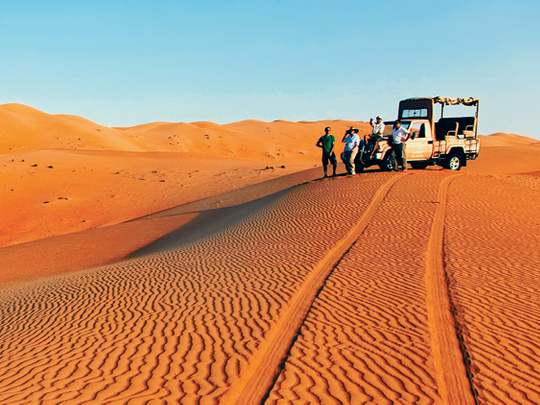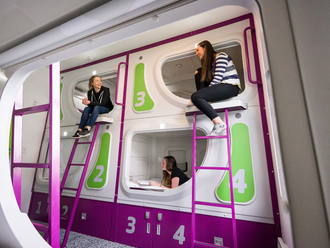
Turns out there are deserts in the UAE after all. In Dubai's concrete jungle, where the sun is often obscured by a cluster of skyscrapers, where shiny malls offer a life far from that of the nomadic Bedouin, in this peripatetic ride from one high to the next, the desert itself often seems like a mirage.
Thankfully, in what seems like minutes after leaving Abu Dhabi city, where we stopped for the night, we're barrelling south along one of the UAE's emptiest roads, paralleling an arterial connect to a rather aromatic incinerator. Ahead, there are camels on our right and what must be the world's largest 4x4 at the grammatically challenged Cars Museum on our left.
But the real shift in perceptions is in the sands, which slowly cast off the greyish hue they acquire in our construction-ravaged cities to reveal a pale neutral colour fashionistas might call nude. As we head towards Hameem, past Portakabins veiled with concrete mashrabiyas and squat green buildings of indeterminate purpose, the sands rise into what Wilfred Thesiger called high and distinct mountains.
By the time we near the Qasr Al Sarab resort in the Liwa desert some two hours later, the sands have changed colour, darkening from golden to orange to red. The hotel, which organises desert drives, camel treks and other adventures in this awe-inspiring part of the country, welcomes us with dates of different dryness and sweetness, all from around the area.
Soon we're back in the car again, as Liwa native Ali Mansouri shows us some of the many forts around this once strategic belt of oases. In a country where history and living memory are often synonymous, these go back centuries, to the UAE's tribal roots, and Mansouri is happy to explain how they were built and by whom.
After a quick lunch at the hotel's Al Waha restaurant (the muhammara is unmissable and they do a mean lamb curry), we pile into a 4x4 with our guide Atif Zaidi to traverse the largest uninterrupted sand desert in the world. It is the high point of the trip — and worth all the driving.
Millennia ago, the majestic Rub Al Kha'ali was part of the Sahara, and though the divisions between the Gulf states are now all fenced off, it's still a vast, forbidding sea of nothingness, its crossing best left to trained drivers.
We've been dune bashing before, but nowhere in the UAE do you scale ridges over 150 metres tall — this is like riding a roller coaster. We take them slow, we take them fast, we approach them nearly perpendicularly. Amazingly, despite powder-soft sand, we don't get stuck. Atif, it seems, knows all the safe passages.
Luckily, we're in time for a spectacular sunset. As the oranges and purples wage war across the skies, the sands change colour again, and except for the 4x4 behind us, we could be anywhere in time. Suddenly, workday weeks and pressing deadlines don't matter any more. Everything is but a grain of sand.








